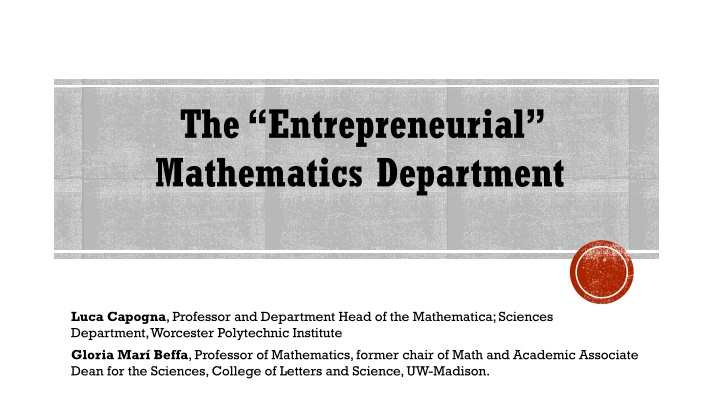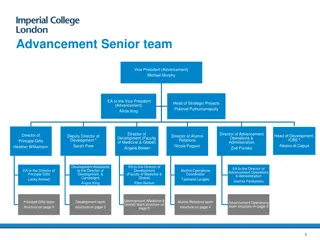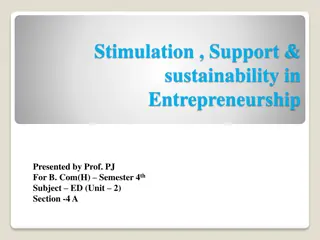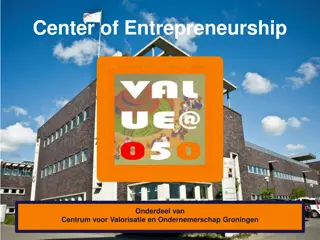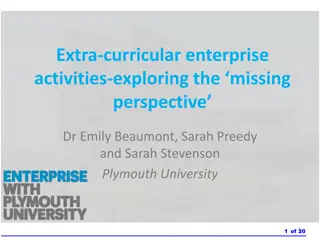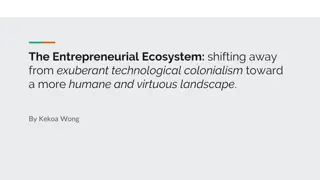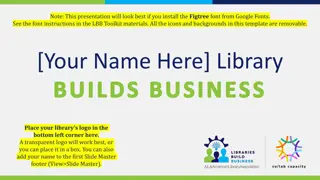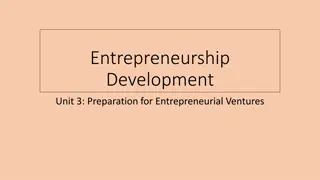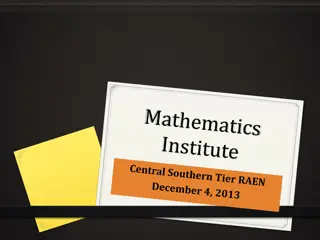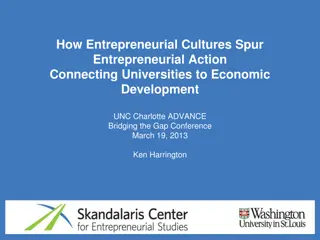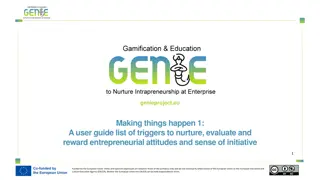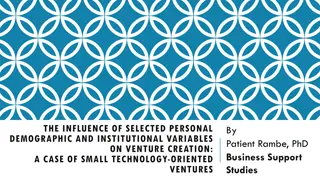Strategies for Entrepreneurial Growth in Mathematics Departments
Explore motivations and strategies for mathematics departments to become more entrepreneurial, including accessing diverse educational opportunities, obtaining external funding, enhancing student competitiveness, and supporting faculty development. Emphasizing collaboration, funding sources, case studies, and leveraging federally supported proposals like NSF Math Institutes. Enhance departmental innovation and impact through strategic partnerships and outreach efforts.
Download Presentation

Please find below an Image/Link to download the presentation.
The content on the website is provided AS IS for your information and personal use only. It may not be sold, licensed, or shared on other websites without obtaining consent from the author.If you encounter any issues during the download, it is possible that the publisher has removed the file from their server.
You are allowed to download the files provided on this website for personal or commercial use, subject to the condition that they are used lawfully. All files are the property of their respective owners.
The content on the website is provided AS IS for your information and personal use only. It may not be sold, licensed, or shared on other websites without obtaining consent from the author.
E N D
Presentation Transcript
The Entrepreneurial Mathematics Department Luca Capogna, Professor and Department Head of the Mathematica; Sciences Department, Worcester Polytechnic Institute Gloria Mar Beffa, Professor of Mathematics, former chair of Math and Academic Associate Dean for the Sciences, College of Letters and Science, UW-Madison.
WHAT WOULD BE MOTIVATIONS FOR A DEPARTMENT TO BE MORE ENTREPRENEURIAL? Access a broader and diverse field of educational opportunities, beyond one s institution. Obtain external/additional funding to engage in such opportunities. Provide students with tools that will make them more competitive in the job market. Provide further professional development opportunities for faculty.
FUNDING AND EDUCATIONAL OPPORTUNITIES BEYOND ONE S INSTITUTION Departments can benefit from collective projects to improve the education offered and can benefit from funding to support such projects. Smaller departments and/or departments with few staff and thinly stretched faculty members can be particularly challenged to become more entrepreneurial. Some Universities encourage their departments to create revenue generating programs that will bring income to the department. Other departments might have engaged in those activities already, reach out.
CASE STUDIES: DOES YOUR DEPARTMENT PARTICIPATE IN ONE OF THESE? HAVE YOU THOUGHT ABOUT ANY? Look beyond the confines of one own s unit: Other units on campus could be allies in educational opportunities or in research proposals; Work with external entities, for example local industry (possibly in need of help on research projects or willing to sponsor student research teams); Reach out to departments in nearby institutions, or through the broad network of NSF math institutes. At WPI this is done through CIMS (Center for Industrial Mathematics and Statistics) and through interdepartmental programs like Data Science (with Computer Science and School of Business) and Computational Biology (with Computer Science and Biology). UW-Madison supports a wide range of revenue generating programs and Mathematics was the first department to create one, looking at market needs and creating a program accordingly.
KEEP AN EYE ON RESOURCES OFFERED BY OTHER FEDERALLY SUPPORTED PROPOSALS, SUCH AS THROUGH NSF MATH INSTITUTES, THROUGH TPSE MATH, THROUGH PIC MATH, ETC ETC LET S TAKE A CLOSER LOOK AT PIC MATH FOR EXAMPLE
MAA PIC MATH PROGRAM Preparation for Industrial Careers in Mathematical Sciences PIC Math works with mathematical sciences faculty to help them prepare undergrads for careers in business, industry, and government by engaging their students in research problems that come directly from industry. DMS-1345499, DMS-1722275 Co-directors: M. Dorff (BYU) D. Narayan (RIT) S. Weekes (WPI)
PIC MATH PROGRAM STRUCTURE a) 3-day faculty training workshop for faculty in summer; b) a semester-long course in which students work on research problems that come directly from industry; c) written & oral research solution submission and evaluation; d) student research showcase at PIC Math Student session at MAA MathFest
2020 DATA SCIENCE WORKSHOPS Featuring R. Paffenroth (WPI) Organized by S. Weekes (WPI), R. Levy (MAA), M. Dorff (BYU)
Group Discussion about success stories (10 minutes) What were the challenges in looking beyond the confines of one own s unit, either towards other department/programs in campus towards external entities, for instance local industry. Are there any success stories? Are there any success stories for entrepreneurial initiatives in partnership with NSF math institutes? Are there any success stories of revenue generating programs supported by central campus?
HOW CAN A DEPARTMENT FIND OUT ABOUT NSF AND OTHER FUNDING OPPORTUNITIES? Sign up for the NSF/DARPA and other news e-mail list. Invite current or former NSF program directors. Invite current or former directors of NSF math institutes. Involve the office of sponsored research. They can keep you updated or give presentations. Other suggestions? (10 minutes discussion)
HOW CAN A DEPARTMENT GIVE SUFFICIENT SUPPORT FOR GRANT-WRITING? If funding allows it, hire grant writers from the outside or from other units in campus to support faculty who are preparing a proposal. If the grant is beyond the standard personal/FRG/RTG grants, offer teaching relief or financial incentives. Writing grants is part of a Professor s job, but some grants are more time-consuming. Ask other faculty who have been successful in external funding to prepare grant writing workshops . If needed, provide occasional teaching reduction for these folks, as they could support more broadly faculty development. Other suggestions?(10 minutes discussion)
HOW CAN A DEPARTMENT CREATE REVENUE GENERATING PROGRAMS Be sure your institution supports it; it will work only if the institution is invested. Think of a market need: a capstone certificate preparing students for a career; a Master bridging two programs; a professional Masters. Collaborate with other units if needed. Play to your strengths and think local or international. Once you have an idea, work closely with your institution. Any more ideas?
DISCUSSION (15 MINUTES) What are the main problems you face when creating additional revenue and/or educational and research opportunities? What are possible solutions to these problems? How do you engage with the upper administration to bring about changes?
